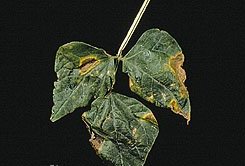Bacterial Blight (Halo Blight and Common Blight) on Dry Beans
Halo blight and common blight reduce dry bean yields by reducing the ability of leaves to photosynthesize.
Host Crops
Dry beans
Biology
Hail, blowing sand or wind-whipping, followed by rain, often trigger bacterial blights. Bacterial blights are also spread if bean rows are cultivated while leaves are wet. The most common bacterial diseases are halo blight and common blight (aka bacterial brown spot).

Halo blight may occur any time during the cropping season. Typical symptoms are small brown spots that are surrounded by a light-green or yellow halo. The halo ranges from dime-size to the size of a quarter. It is caused by a toxin produced by the halo blight bacterium when the temperatures are less than 21ºC(70ºF) for at least part of the day. In hot weather, halo blight will resemble bacterial brown spot.
Both diseases are carried on the seed and can be spread from plant to plant by rain, hail, irrigation, or wind. In the soil, blight can survive in old, diseased plants for a year or longer.
Symptoms Of Damage
Common blight and halo blight cause water-soaked, greasy looking spots on pods and dead spots surrounded by a chlorotic halo on leaves. The dead areas enlarge rapidly under favourable conditions until they cover most of the leaf, giving the plants a burned appearance. Pod lesions may appear as small, brown, scabby spots.
Scouting Techniques
A laboratory culture may be required to confirm field identification of a bacterial disease and to distinguish between the bacterial blights. Look for water-soaked spots on the leaves. The areas surrounding the spots may be yellowish, brown and brittle.
Control Tips
- Plant disease-free seed. This is important because all outbreaks of the disease have resulted from planting infected seed.
- Use a two- to three-year crop rotation to avoid the chance of contaminating the newly planted crop.
- Turn under plant debris as soon as possible after harvest to allow enough time for the debris to disintegrate over the winter. Avoid over-irrigation.
- Do not work in infested fields that are wet with rain or irrigation water. Seed treatment helps prevent seed rot and damping off but will not control blight because the blight organism is often within the seed. Copper based fungicides slow down the spread of halo blight but they are only moderately effective. They must be applied early in the season and repeatedly to provide control.
